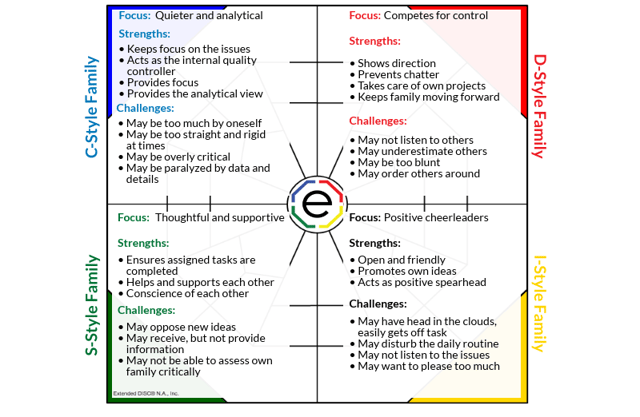DISC helps you better understand your interactions with family members and how your family functions as a unit.
Many people know DISC as a workplace communication tool, so how can it help improve your interactions with family members? Our tool was originally developed for the workplace, but DISC truly transcends all areas of your communication. Being able to you improve your ability to relate well to clients and coworkers, can naturally translate to your personal interactions. Those family gatherings may begin to feel more comfortable and enjoyable.

How is DISC Different When Describing Family Communication?
There are some differences when relating to family members versus coworkers. You're more likely to be in familiar and comfortable surroundings; meaning family members are likely to observe your natural style (Profile II). For the same reasons, your family member's natural style will likely show up as well. When we are in comfortable and familiar situations, we are less motivated to adjust our style (Profile I).
Have you ever come home from work tired and cranky? More often than not, our emotions are more involved in our home than at work. Fatigue, stress, and anger are strong emotions that further impede our ability to adjust our style to the situation.
So where do we start? First, we need to understand our own behavioral DISC and how we relate to others. Next, we can identify the DISC styles of our family members. Once we recognize how we interact, then we can make those important adjustments in order to succeed in family communication.
How D-style Family Members Communicate
 D-styles want to be in charge. Have you ever had that irritating relatives that loves to push your buttons? Have you been in a discussion with a family member and these relatives interrupt to "fix" your problem with unsolicited advice? Do they get irritated when others are not on their schedule? For example, they tell everyone it's time to eat, and without waiting, start dishing out their plate. Yet, they excel at taking control in unforeseen crises. If the dog runs in and steals the turkey leg off of Grandma's plate, they will immediately take charge amidst the chaos.
D-styles want to be in charge. Have you ever had that irritating relatives that loves to push your buttons? Have you been in a discussion with a family member and these relatives interrupt to "fix" your problem with unsolicited advice? Do they get irritated when others are not on their schedule? For example, they tell everyone it's time to eat, and without waiting, start dishing out their plate. Yet, they excel at taking control in unforeseen crises. If the dog runs in and steals the turkey leg off of Grandma's plate, they will immediately take charge amidst the chaos.
Remember that your D-style family member needs to feel in control. Give them the sense that they have a choice when involved in family discussions. Focus your communication on bullet point summaries; don't focus on details. Be prepared to listen more than speak. Enjoy debating, but don't always take the bait or take it personally. They may come across as blunt and inconsiderate, but they may just simply be less emotionally focused than you.
How I-style Family Members Communicate
I-styles are your family's social butterflies. They love telling stories and being the center of attention. As a kid, you may have tried to hide from your I-style family members because they are the huggers. They'll float from person to person looking for as many chances to interact as possible. You always know where they are because they are louder, more animated, and often surrounded by a captive audience. They get so excited they forget which stories they've already told you, and end up repeating the same story. Luckily, the same stories get more and more colorful over the course of multiple family gatherings.
Be prepared for a hug even if it's quick. Spend an extra five or ten minutes actively listening and responding with positive comments. Chances are the story will be funny and interesting. Enjoy the interaction!
How S-style Family Members Communicate
 S-styles tend to focus on the family as a unit rather than putting themselves first. Do you have those family members that help out behind the scenes at all gatherings? They quietly help to clean up and wash dishes. They are easy-going and great listeners.
S-styles tend to focus on the family as a unit rather than putting themselves first. Do you have those family members that help out behind the scenes at all gatherings? They quietly help to clean up and wash dishes. They are easy-going and great listeners.
Remember to draw out your S-style family member's opinions. Ask them questions to get them talking. Don't take advantage of your S-style family member. They probably would never say "no" to family, yet resentment can build up if they feel taken advantage. Then stand back and watch the explosion!
How C-style Family Members Communicate
C-styles are more reserved and can be less comfortable or even overwhelmed at family gathers; and instead wishing they were at home reading a book. They show up because it's seen as "required" for family members. They may quietly slip out before the festivities end. They appear exhausted from all the activity around them.
Consider finding a topic that you know interests them. Find a quieter place to have a one-on-one conversation. Be comfortable with silence and time to process because your C-style family member is. Remember, your C-style family member may be more economical in their word choices; "fine" may be considered positive feedback for them.
Family Communication and Family Member Assessments
Once you have identified you own style, you can assess the style of others. Recognizing how the other person prefers to communicate will help determine if your natural approach is effective or if you need to modify your approach.
We see interactions through our own lenses; probably more so when we are miscommunicating. We need to be able to reframe it from the other's vantage point so we can improve the result. It does not mean we have to change who we are or come across as insincere.
It does mean that by altering a few of our behaviors in the visual, vocal, and verbal channels of communication we acknowledge and respect human differences in perspective and reactions. As Stephen Covey stated: "Seek first to understand, then be understood."
Make that Next Family Gathering the Best One Yet
 After relaxing into the festivities D's and C's may start to argue who's correct while the I's and S's are trying to keep the peace and keep everyone feeling good. The key to successful family communication is to have an effective plan in place. First, be aware of your own behavioral style and how you prefer to do things. Then consider how you would effectively improve your communication with each family member and within your family. With family members, we are less likely to adjust our style. We may even expect family members to communicate in our own preferred style.
After relaxing into the festivities D's and C's may start to argue who's correct while the I's and S's are trying to keep the peace and keep everyone feeling good. The key to successful family communication is to have an effective plan in place. First, be aware of your own behavioral style and how you prefer to do things. Then consider how you would effectively improve your communication with each family member and within your family. With family members, we are less likely to adjust our style. We may even expect family members to communicate in our own preferred style.
We view our actions and actions of others through our own perspective and based on our own DISC style. DISC helps us recognize that others may have different behavioral styles and different ways of doing things. In order to make adjustments to communicate well we need to first recognize our behavioral style and then the styles of our loved ones. Making adjustments will take practice. Luckily with family you'll have plenty of opportunities to practice. Once we make the proper adjustments we can improve our family relationships.
